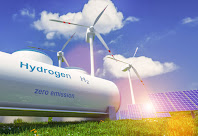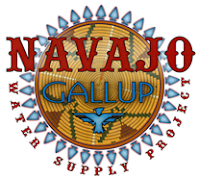Thursday, June 15, 2023On The Enviro Beat: Chaco Canyon Buffer Is Not Uncomplicated, Hydrogen Energy Takes A Beating And Navajo Gallup Water Project Plods AlongFirst an addendum to the Wednesday blog. ABQ GOP state Senator Mark Moores announced after that blog came out that he will not seek re-election to a fourth term. The news came as we reported that businessman David Doyle is prepping to run for the GOP nomination and that former BernCo Commissioner Michael Wiener is already in the race. Now today's edition. . . . One thing about the enviros. They specialize in complicated stuff. This week gave prime examples. First and foremost was the controversial buffer zone established by Interior Secretary Haaland around Chaco Culture National Historical Park to protect it from oil and gas drilling. This piece from the Farmington Daily Times reveals how all over the map the predictions are over what the real impact will be. Will Navajo "allottees" who Sunday blocked a road to prevent Haaland from celebrating the buffer still be free to exercise their mineral rights and lease their lands? Uh, maybe. Are environmental groups predictably elated over the long-sought buffer? Well, not really. Has the buffer divided the pueblos from the Navajos? That one is a definitive yes. HYDROGEN HOLD UP Meanwhile, MLG's push to locate a hydrogen production center in the state continues to draw opposition from environmental groups. We get this: A coalition of Indigenous, climate, environmental justice and youth advocates urged the Department of Energy to reject funding for the Western Interstate Hydrogen Hub, which is intended to rapidly expand hydrogen production in Colorado, New Mexico, Utah and Wyoming. “Our BIPOC, low-income and youth communities are already facing the brunt of the climate crisis,” said Ennedith Lopez, policy manager at Youth United for Climate Crisis Action. “By doubling down on hydrogen instead of true renewables like solar and wind, the WISHH project will exacerbate these inequities even further. . . Instead of enforcing the environmentally racist practices that got us here in the first place, Gov. Lujan Grisham and President Biden need to declare a climate emergency now and invest heavily in real solutions. . . More than 99% of hydrogen produced today uses fossil fuels in a process that harms human health and emits carbon dioxide." Okay, but implying that MLG and Scranton Joe are racist is a bridge too far. The group says the Biden administration is "investing $7 billion to develop 10 clusters of hydrogen production. The Energy Department is reviewing applications for funding, including one from the Western Interstate Hydrogen Hub. In April the group applied for $1.25 billion in federal funds. It would fund eight hydrogen projects, with at least one in each of the four states." Groups in the coalition are: Pueblo Action Alliance, Indigenous Lifeways, Tó Nizhóní Ání, Los Jardines Institute, Youth United for Climate Crisis Action Earth Care, New Energy Economy, WildEarth Guardians, Center for Biological Diversity. Efforts to thwart hydrogen development at the Roundhouse have been successful, stalling MLG's plans to incentivize the industry. Sen. Heinrich, an ardent enviro, has been an advocate of hydrogen as a clean energy source. He says: Clean hydrogen is a high-energy fuel source that does not emit greenhouse gases at the point of use, properties that allow it to be used in intense and long duration applications. These traits make it an attractive fuel source, especially for hard-to-abate sectors like shipping and industry. A search did not turn up any public statements by Interior Secretary Haaland on the administration's hydrogen production plans. We'll update if we get something. SLOWLY UNFOLDING We've been watching one of the largest (and most ambitious) public works projects in state history slowly but surely unfold ever since Congress authorized the Navajo Gallup Water Supply Project in 2009. It was not going to be cheap and the Feds say the water delivery plan is now projected to cost close to $1.9 billion (with more upward projections likely to come). And that takes us to the NM DC delegation who come with this: U.S. Senators Luján and Heinrich introduced legislation that amends the Navajo Gallup Water Supply Project to ensure it has the resources and time needed to reach completion to deliver drinking water to northwestern New Mexico communities. The House companion will be introduced by Rep. Leger Fernández. . . The Project was first authorized (in) 2009. . .and funded the design and construction of the waterline to reach an estimated 250,000 people by the year 2040. Upon completion, the Project will provide a long-term, sustainable water supply from the San Juan River to roughly 43 Chapters on the eastern Navajo Nation, the southwestern portion of the Jicarilla Apache Nation, and the City of Gallup, which currently rely on a rapidly depleting groundwater supply of poor quality. . . .Full project completion is planned for 2029. It will include approximately 300 miles of pipeline. . .New legislation is required to authorize additional time and resources to complete the project. “On the Navajo Nation, approximately 15,500 households live without running water or haul drinking water to their homes. The Navajo-Gallup Water Supply Project will provide a reliable and more sustainable surface water supply. . .for the region. . .This legislation will make sure the Navajo Nation’s Indian water settlement project will be completed by 2029 and fully funded." Said Sen/ Lujan. The latest update from the Bureau of Reclamation: In 2020, water deliveries to Navajo communities began on the Cutter Lateral. Deliveries to the Jicarilla Apache Nation from the Cutter Lateral are anticipated to begin in 2021. On the San Juan Lateral, construction is underway and is anticipated to be completed in 2028.
And that concludes today's enviro beat. Heck, even enviro Jim Baca might slap us on the back for all that info. MEMORY LANE
Steve Haro was Martin Heinrich's political adviser in the '10 US House campaign. We had his first name incorrect. And in 2012 Heinrich filled Sen. Bingaman's seat, not Pete Domenici's. At this point we have so many years of campaign memories that we're going to have to rely on the history books as well as our personal recollections. "They start to blend together," emailed one veteran operative. Glad to see folks enjoyed the short walk down memory lane. We'll take another soon. THE BOTTOM LINES We joined veteran Santa Fe radio talk show host on KTRC this week and discussed national, state and local politics. The conversation is here. Reporting from Albuquerque, I'm Joe Monahan. This is the home of New Mexico politics. E-mail your news and comments. (newsguy@yahoo.com) |
  |






